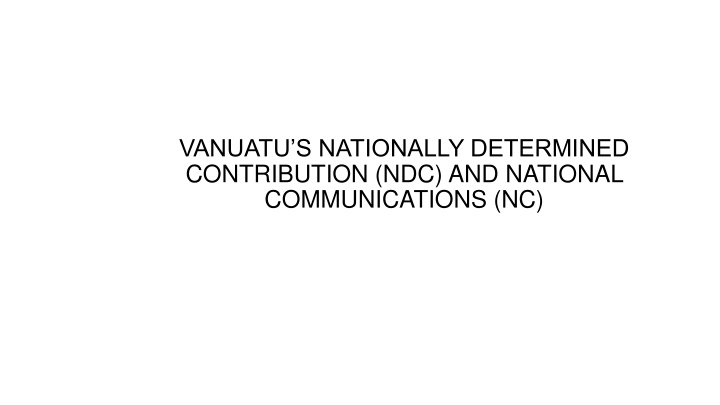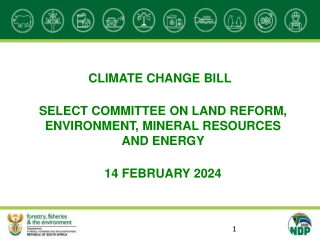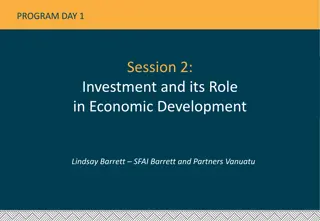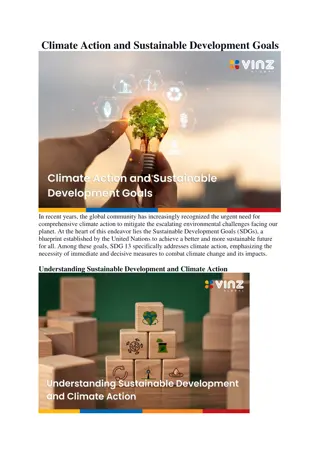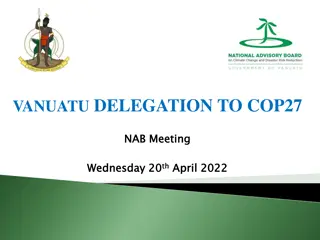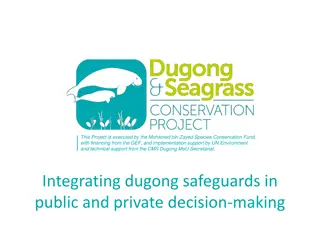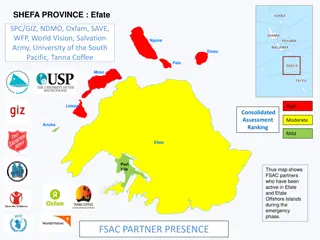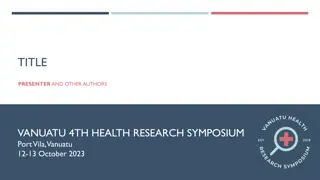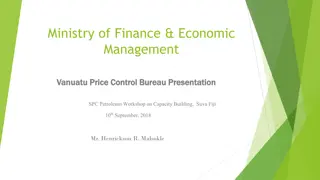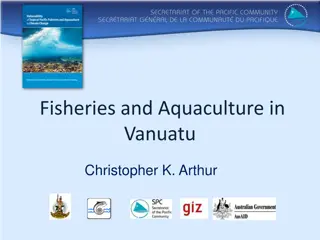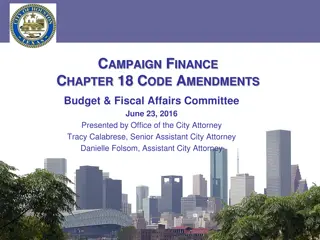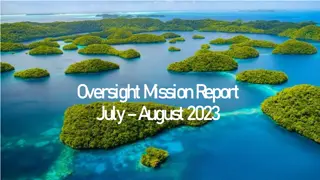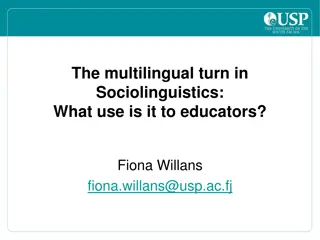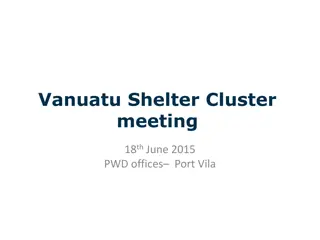Vanuatu's Contribution to Global Climate Action
The Paris Agreement marked a significant milestone in international climate negotiations, paving the way for decarbonisation efforts globally. This article discusses Vanuatu's Nationally Determined Contribution (NDC) and National Communications (NC), highlighting the importance of ratification, entry into force, and domestic implementation of NDCs. It also touches upon further positive signals such as the ICAO agreement and the Kigali Amendment, stressing the need for continued action to limit temperature increases. Looking ahead, 2018 will be crucial with the publication of the IPCC Special Report on 1.5°C and the focus on raising mitigation ambition through the Facilitative Dialogue and finalizing the Paris Agreement "rulebook" at CoP 24 in Poland.
Download Presentation

Please find below an Image/Link to download the presentation.
The content on the website is provided AS IS for your information and personal use only. It may not be sold, licensed, or shared on other websites without obtaining consent from the author.If you encounter any issues during the download, it is possible that the publisher has removed the file from their server.
You are allowed to download the files provided on this website for personal or commercial use, subject to the condition that they are used lawfully. All files are the property of their respective owners.
The content on the website is provided AS IS for your information and personal use only. It may not be sold, licensed, or shared on other websites without obtaining consent from the author.
E N D
Presentation Transcript
VANUATUS NATIONALLY DETERMINED CONTRIBUTION (NDC) AND NATIONAL COMMUNICATIONS (NC)
The Paris process The Paris Agreement marks a breakthrough in international climate negotiations. Paris was the start of a process towards global decarbonisation in the second half of the century Main tasks after Paris include: Ratification and entry into force (completed) Agreement on a package of implementing decisions (the Paris rulebook ), scheduled for 2018 Some progress during CoP 23 Domestic implementation of NDCs (asap) Preparations for raising ambition, starting with the Facilitative Dialogue in 2018 (Talanoa Dialogue CoP 23) to identify relevant opportunities to enhance the provision of financial resources with a view to identifying ways to enhance the ambition of mitigation efforts by all Parties, 2
RATIFICATION AND ENTRY INTO FORCE Ratification and entry into force of the Paris Agreement were a first test for the commitment of the international community a big success On 5 October 2016 both conditions for entry into force were met (ratification by at least 55 countries representing at least 55% of global GHG emissions) Entry into force on 4 November 2016 in less than a year after the historic breakthrough in Paris! 3
FURTHER POSITIVE SIGNALS ICAO: Agreement reached on a new market-based measure to limit emissions of international aviation Montreal Protocol Kigali Amendment: Agreement on a phase- out of HFCs Together with commitments in (I)NDCs these measures imply a temperature increase of around 2.7 C above preindustrial levels That is less than the high IPCC scenarios, but still significantly more than the 2 and 1.5 C of the Paris Agreement. Much remains to be done! 4
WHAT NEXT? 2018 will see publication of IPCC Special Report on 1.5 C and a FacilitativeDialogue to raise mitigation ambition, plus agreement on the Parisrulebook a big year for global climate action The Paris Agreement "rulebook" is meant to be finalized next year during CoP 24 in Poland. Doing that will require sorting out a number of issues that have frequently divided developed and developing country constituencies at these international climate talks. No time to wait: With the Paris architecture, action is to take place through implementation of NDCs work must start immediately 5
The Year Ahead Road to CoP 24 Two issues in particular stand out.: Developing countries want their wealthier counterparts to be much more specific about the climate finance they plan to provide to help vulnerable nations mitigate emissions, adapt to and cope with the impacts of climate change. The rules for how this money gets counted and reported still have to be decided, and civil society groups have charged that so far developed countries are prone to overcounting the money they are putting forward. Countries also still need to reach a final decision about the Adaptation Fund, which lost its funding stream when the international carbon market collapsed, and has been living donation to donation ever since. At COP23 delegates decided that this fund which is very popular among developing countries will have a place under the Paris Agreement, but they still haven t decided where consistent money will come from, or if the Adaptation Fund will have to see some structural changes
Vanuatu BAU GHG Emission Emissions scenarios given in the SNC suggest that without intervention, total CO2 eq. emissions are projected to rise sharply over the next decade The existing GHG emissions and BAU projections are also well reported in the SNC and are suggested to amount to around 700 Gg CO2 eq. in 2010. On a per capita basis the 2010 value would give emissions of around 3 tonnes per capita relative to a world average (2016) of around a little over 6 tonnes. It is important to note that the problem GHG gasses in Vanuatu are the CH4 emissions associated with the agriculture sector (mainly ruminants). If just CO2 is counted, the 2010 energy emission would give a per capita emissions level (2010) of around 0.5 Tonnes per capita or well below the world average.
Vanuatu - Summary of (I)NDC Contribution - Mitigation The main mitigation contribution is to achieve the outcomes and targets under the updated National Energy Road Map (NERM) and Second National Communication (SNC) extended to 2030. The mitigation contribution for the Vanuatu (I)NDC submission is a sector specific target of transitioning to close to 100% renewable energy in the electricity sector by 2030. This target would replace nearly all fossil fuel requirements for electricity generation in the country and be consistent with the updated National Energy Road Map (NERM) target of 100% renewable energy by 2030. This contribution would reduce emissions in the energy sector by 72,000 tonnes by 2030. Emissions in this sector were around 130,000 tonnes in 2010 but are expected to rise to 240,000 tonnes by 2030 (3% per annum).
Vanuatu - Summary of (I)NDC Contribution - Mitigation The mitigation would thus reduce BAU emissions in the electricity sector by 100%. The target would be conditional, depending on funding ( around US $ 180 million) commensurate with putting the transition in place being made available from external sources. In addition, Vanuatu will pursue the other mitigation measures in the updated National Energy Roadmap (2016- 2030), the Scaling Up Renewable Energy in Low Income Countries (SREP) report, Rural Electrification NAMA and Vanuatu s Renewables Readiness Assessment (RRA) report undertaken by IRENA. These measures would also include a vigorous program of energy efficiency to reduce emissions in all sectors except agriculture and forestry by 15%. Opportunities for reducing the high emissions levels in agriculture (Livestock) will simultaneously be pursued with cooperative programs with nations having similarly high emissions in this sector. The forestry sector mitigation will be attended to as part of the existing REDD+ program.
Fairness and Ambition Vanuatu s past emissions have been miniscule and have only become locally significant in the past decade or two. In general development issues dominate rather than climate change mitigation. Vanuatu is a small developing nation with absolute levels of CO2 eq emissions very small at under 0.0016% of world emissions. The country is also one of the most vulnerable to the effects of climate change and has much to lose should the worst predictions from increased temperature levels eventuate. As such the country will do its best to mitigate but would require financial, technical and capacity building support to do so.
Vanuatus Greenhouse Gas Emissions (Year 2000) - Second National Communication - 2016 Total national GHG emissions excluding removals in year 2000 were 585.39Gg CO2e 2.1% 12.0% Energy Sector: 70.34Gg CO2e Agriculture Sector: 502.83Gg CO2e Waste Sector: 12.21Gg CO2e Energy Agriculture Waste 85.9%
Contribution of Various Sub Sectors in GHG Emission (Year 2000) 2.1% 0.2% 5.2% Energy Industries 0.7% 5.9% Manufacturing Industries and Construction Transport 29.4% Other Sectors Livestock N2O from Agriculture Soils 56.5% Waste
Energy Sub Sectors GHG Emissions in Vanuatu (Year 2000) 0.1% Energy Industries 1.7% 0.4% 5.7% Manufacturing Industries and Construction Civil Aviation 42.9% Road 43.5% National Navigation Commercial/Institutional 4.1% Residential Fishing 1.5%
GHGI Key Findings - SNC Activity data for most of the sectors/categories for estimating GHG emissions is available but is not consolidated and readily available. Insufficient documentation of methods and data sources used for data collection, this in turn adversely impacts the reliability of the data. There is lack of country-specific emission factors in Vanuatu and hence IPCC default values are generally used in estimating the GHG emissions. Lack of detail in the activity data as with other LDCs. For example in the energy sector there is substantial information available on fuel imports but limited information is available on end use consumption. There are no major industries in Vanuatu and emissions from the existing micro scale industries (such as food and beverage producing) is negligible, there is no or limited data available for estimating GHG emissions from IPPU sector.
GHGI Key Findings There is very limited farming activity in Vanuatu and hence limited use of fertilizers in the country, the data of fertilizer usage is not currently available. Lack of technical and financial resources to support GHG and associated climate change studies. There is need for technical & financial assistance to support GHG inventory development related activities (Data collection, assessment, archiving, technical committees, training on software etc).
Recommendations Develop appropriate templates to facilitate data collection for GHG estimation for various sectors. Collaborate with Annex-1countries to obtain high-quality satellite data and aerial imagery needed for forestry and land use sector Train team working on compiling GHG inventory on using UNFCCC software and IPCC methodology requirements Climate change unit could lead the efforts to mainstream GHG compilation initiative in the country and set guidelines for inventory improvement in terms of data availability, quality and detail. There is need for capacity-building activities in the country for preparing GHG inventory. These exercises need to focus on training and capacity building on data gathering, archiving and ascertaining quality of data. There is need for technical and financial assistance to support GHG inventory development related activities Develop/Procure specially designed electronic hardware and software for GHG inventory related work including a systematic research, monitoring and information collection system
SNC - Vanuatus Projected Total GHG Emissions (excluding Removal) Total GHG Emissions, excl. Removals (Gg CO2e) 1600 1465.07 1400 1144.74 1200 1000 896.61 800 720.67 616.93 585.38 600 400 200 0 2000 2005 2010 2015 2020 2025 Total GHG Emissions, excl. Removals
SNC - Climate Change Mitigation Opportunities Energy Sector Promotion of Renewable Energy technologies (Grid connected and off grid) i.e. mini and micro hydro, solar, wind, biomass etc. Small and mini grid for renewable energy electrification Promotion of Bio-Fuels Promotion of Renewable Biomass based power generation (Gasifier) Demand Side energy efficiency measures Promotion of energy efficient appliances (standardization and labelling of energy consuming appliances) Green and energy efficient building standards Promotion of Building Energy Efficiency Encourage public energy awareness to reduce use of high power consuming appliances Promotion of cleaner fuels, efficient cook stoves and solar lanterns Efficiency and Emission norms for Generators Awareness, Training and Capacity building programs Provision of information on low carbon development and clean technologies
SNC - Climate Change Mitigation Opportunities for Vanuatu Transport Sector Promotion of fuel efficient vehicles Norms for efficiency & pollution for vehicles Promote public transportation services Upgrading of road network and Traffic Management Agriculture Sector Labelling of energy consuming appliances (pumps etc.) Promotion of Renewable energy technologies (Solar Dryers/pumps etc.) Land use management Awareness, Training and capacity building programs Waste Sector Promotion of Waste Management (Reduce, Reuse, Recycle) Landfill or composting of solid waste Waste water treatment Waste to Energy - Promotion of Biogas technology
Main issues/constraints in Planning, Implementation of Mitigation Measures Insufficient institutional and financial capacity, lack of resources to develop and implement the mitigation measures Low Energy demand and distributed community with large distances between consumers Low population density and limited outreach Limited cash availability in rural areas to pay for high cost options and services Limited technology know-how and very limited technical capacity in rural areas Limited private sector development and limited capacity for rural energy businesses Lack of standards and specifications Infrastructure limitations and very limited market development Land disputes hamper potential site development for renewable energy projects Institutional weaknesses including shortage of funds hampers the availability and attraction of adequate qualified staff and limits further development of skills as well as the implementation of mitigation activities
Second National Communication Second National Communication - - 2015 2015 Adaptation Priorities NAPA Agriculture and food security Development of resilient crop species including traditional varieties Land use planning and management Water resource management Sustainable forest management Marine resource management and aqua culture Climate change and infrastructure Sustainable livestock farming and management Integrated coastal zone management Sustainable tourism development Vector and water borne disease management 21
